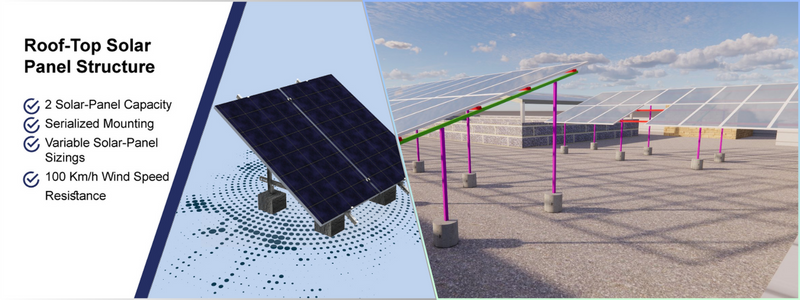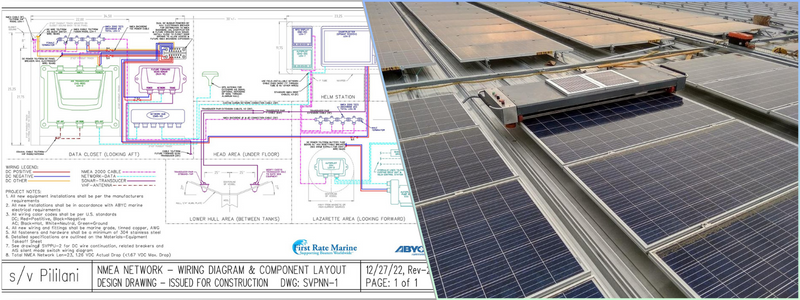Today’s post covers solar panel drafting and design rates and costs for commercial and residential plans. A big part of the clean energy movement, amidst the looming threats of climate change and worsening air pollution worldwide, is the adoption of solar panels in residential and commercial applications. Solar panels collect photons from sunlight and store them as direct electrical current (DC). An inverter converts the energy into a readily usable alternating electrical current (AC).
Besides solar panels and inverters, a complete solar power system also consists of charge controllers, storage batteries, racks, and mounts. Solar power, or electricity from the sun, is clean and renewable. It does not generate pollutants as byproducts, and the sunlight is available free of charge for everyone. That said, the range of equipment required to convert the photons into electricity is not free. If you are considering solar panel installation for your company or home, a renewable energy expert can help.
RELATED: How 3D modeling, rendering, and CAD design helps architects create sustainable construction
Solar panel drafting and design: rates and costs for commercial and residential plans
Lower bills
With a solar panel installed, you don’t have to purchase the energy required to power your home or office. It takes the same amount of electric power to charge a laptop, activate the heater or air-conditioning, or turn on the lights when using solar power.
However, you don’t use electricity from conventional sources, which means you help reduce the overall workload across the grid. Because you consume less (if at all) energy sent from the grid, your electricity bill should be lower than average without sacrificing comfort and convenience. Solar panels have the potential to enhance the value of your home.
RELATED: 47 Eco-friendly product designs to inspire you
Solar panel installation cost
Pricing estimates for solar panel installation vary by state and region. Typically, regions with more sunny days each year tend to have more substantial incentive programs, whereas areas located farther from the equator, like Alaska, may not provide as strong incentives. On average, solar panel installation cost ranges from $15,000 to $25,000. Besides the location, the price is also affected by electricity requirements, panel type, size, and installation system. Solar panel installation is a complex process, therefore it’s necessary to invest in solar panel drawing services during the planning stages.
Types of solar panels
Some of the most common types of solar panels typically installed in residential and commercial establishments are as follows:
- Monocrystalline: solar panels of monocrystalline type are made of high-grade silicon. It is the most efficient type and can generate electricity from more than 22% of sunlight collected. Many providers offer up to a 25-year limited warranty for a monocrystalline panel. Thanks to its high efficiency, only a few panels are required to generate the same amount of electricity as the alternatives.
- Polycrystalline: constructed from silicon fragments, polycrystalline panels are more affordable than monocrystalline but are also efficient. The panels can generate power from 16% of photons absorbed at their best.
- Thin-film: the uppermost layer of the panels is covered with photovoltaic materials to collect photos. The installation of thin-film panels requires notably larger space than monocrystalline or polycrystalline. They produce electricity from 14% of the energy absorbed from the sun and are primarily used in industrial buildings.
RELATED: The evolution of 3D CAD design and drafting

There is also a PERC (Passive Emitter and Rear Cell) panel, which is an improvement over monocrystalline. Any amount of unabsorbed sunlight hits the back layer and is bounced back to flow through the solar cells. PERC offers minimum energy loss and effective heat management.
Another option is a bifacial panel, a two-sided monocrystalline, which can generate electricity from lights reflected on the rear side. It is the most expensive type, found mostly on large-scale commercial projects. Although such panels are not intended for the residential market, some people install the system in rooms or places where the sunlight is supposed to leak through the roofs, such as carports and patios. Enlist the help of a solar panel design expert to help you make an informed decision.
Most solar panels can last decades with up to a 25-year warranty. They are not cheap, and you probably will not see a return on investment until they have been operating daily for 7 – 8 years. In financial terms, the amount of savings is in the range of $10,000 to $30,000 over the course of 20 years, but it entirely depends on the location and cost of electricity (from conventional sources).
RELATED: Why you should outsource to CAD drawing and drafting services
Solar panel installation process
Solar panel providers and installers have their individual workflow preferences, but most of them follow the same steps listed below:
Compatibility check
Solar panel installation doesn’t have to connect with the existing electrical wiring, but any user will utilize the new system to power the already in-place appliances, devices, lighting, and electronics. The good thing is that solar panels, regardless of the type, can work with any conventional system as long as it is up to date. Roof readiness is the main point of a compatibility check; the roof must be large and strong enough to support the panels.
Panel size selection
Based on the roof readiness analysis, you can select the appropriate panel size and the number of panels to install. The desired capacity will determine panel size. Selling the electricity generated back to a power company is possible, but it demands a substantial investment and ample space for a high-performance system. For typical household usage, some solar panels covering an entire roof of the house will likely suffice.
RELATED: Drafting services rates vs. architectural development costs & differences in pricing
Acquiring permits
At least in the United States, you need two permits before installing solar panels for your home. One permit is from the local building authority, and another is from the currently connected power company (for interconnection).
Purchasing equipment
Solar panel installation requires a specific assortment of equipment, which may vary depending on the system specification. Purchase the equipment from the same provider at the same time to ensure compatibility.
Installation
Once everything is ready and you obtain the necessary permits, it is time to install the system. The first component to build is the racking system, followed by the panels, heat sink, and controllers. Batteries, inverters, and power meters come next. The installers recheck the wiring before activating the system or connecting it to the electrical panels.
RELATED: 12 Benefits of outsourcing your company’s CAD services
Between submitting the solar panel design drawings for permit and purchasing the equipment, consider applying for government incentives to lower the overall cost. The amount and types of incentives may vary by state and locality. There are even federal incentives for US citizens, but the details change occasionally, so it might be necessary to consult a solar professional. If possible, apply for all incentive programs for which you are eligible, such as tax credits, grants, and rebates. Ensure every matter related to incentives and permits is settled before construction begins.

Solar panel system configurations
Solar panels can be set up in various configurations to optimize electricity generation for specific purposes and usage. A passive solar design professional can help you make the right choice for your specific needs.
Grid tie
The most pragmatic and budget-friendly setup is a grid-tie system, where solar panels generate electricity and inject it into the grid. You contribute to the grid’s electricity production in exchange for lower bills. Such a configuration does not require batteries, so the power goes out when the grid is down.
RELATED: BIM consulting & drafting services by Cad Crowd freelancers
Off-grid
An installation system without connection to a power company. The solar panel functions as a stand-alone electricity generator. Since the panels are off-grid, the system often has to be oversized for reliability reasons. It is more expensive than the “grid-tie” option.
Hybrid
Priced like an off-grid system, a hybrid solar installation does not require oversized batteries as it connects to the power grid. The electricity generated from the panels is used directly in the building, but in an emergency (the panels do not receive enough sunlight), the building can switch back to a grid connection.
Solar panels achieve their highest efficiency when they are installed correctly. This involves ensuring equipment compatibility and proper wiring and paying attention to fundamental factors such as roof characteristics and geographic location. Even with bifacial monocrystalline panels, efficiency suffers if the panel positioning negates sunlight absorption or the roof has a steep pitch. As a better-safe-than-sorry measure, homeowners (or even providers) can hire solar panel drafting and design services to help with planning.
RELATED: Discover why your business should use CAD services instead of manual drafting
Solar panel drafting and design services
The installation process of solar panels for residential or commercial buildings involves extensive paperwork. Homeowners must obtain building permits before construction; they also want to apply for state and federal incentives. The most time-consuming part of the solar panel installation process is the waiting period for permit issuance.
Submitting professionally-drafted solar panel design drawings can improve your chances of quick permit approval. More importantly, qualified engineers can figure out all the technical details related to the installation and efficiency, including but not limited to the following:
- panel positioning
- mounting design
- roof or structural framing
- wiring schematics
- attachment details
- electrical panels
- battery system
- interconnection with a power grid
Solar panel drafting is a technical document with specification information for all major equipment and a detailed site plan. Some drafters offer optional Bill of Materials documents. Remember, solar panel installation is at the same scale as a major renovation project. A well-drafted construction plan minimizes construction mistakes and prevents an overbudget issue.
RELATED: How much do CAD drawing services cost for design drafting & architectural blueprints?
A solar panel drafting and design freelancer charges around $100 to $200 for a complete plan set, including system layout, structural details, wire diagrams, specification sheets, equipment labeling, certification documentation, and site plan. Solar panels’ power generation capacity may affect the price, but not by much. If a plan set for a 0-10 kW system costs $120, the bigger 10-15 kW configuration should cost around $150.
According to the US Bureau of Labor Statistics, the average hourly rate for Electrical and Electronics Drafters (whose job also covers solar panel drafting and design services) in the United States is $31.60. However, most professionals surveyed are full-time employees. Based on various data from various jobseeker marketplaces, freelancer electrical drafters charge around $25 per hour on average.
RELATED: Hire a freelancer for BIM drafting & conversion services on Cad Crowd
Here’s a table summarizing the cost of a solar panel drafting and design professional:
| Service Description | Cost Range |
|---|---|
| Complete Plan Set (0-10 kW) | $100 – $120 |
| Complete Plan Set (10-15 kW) | $120 – $150 |
| Hourly Rate for Freelancer Electrical Drafters (average) | $25 per hour |
| Average Hourly Rate for Electrical and Electronics Drafters | $31.60 per hour (full-time employees) |
Please note that the cost for a complete plan set may vary based on the power generation capacity of the solar panel system. The hourly rate for freelance solar panel drafting & drawing services is typically lower than that of full-time employees in the field.
RELATED: What are AutoCAD designer rates, drafting costs & services company pricing?
How Cad Crowd can help
By using Cad Crowd’s experienced and pre-vetted professionals, you can have a customized plan developed for your specific needs. This plan can be passed along to the people who will install your panels so they can do their work as smoothly and efficiently as possible. The installation phase is always more cost-intensive than the planning phase, so it is worth planning carefully ahead of time. Contact us for a free quote.
